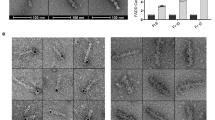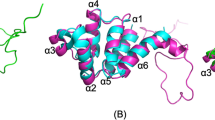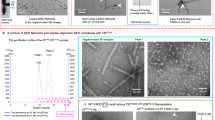Abstract
Receptor-mediated programmed cell death proceeds through an activated receptor to which the death adaptor FADD and the initiator procaspases 8 and/or 10 are recruited following receptor stimulation. The adaptor FADD is responsible for both receptor binding and recruitment of the procaspases into the death-inducing signaling complex. Biochemical dissection of the FADD death effector domain and functional replacement with a coiled-coil motif demonstrates that there is an obligatory FADD self-association via the DED during assembly of the death-inducing signaling complex. Using engineered oligomerization motifs with defined stoichiometries, the requirement for FADD self-association through the DED can be separated from the caspase-recruitment function of the domain. Disruption of FADD self-association precludes formation of a competent signaling complex. On this basis, we propose an alternative architecture for the FADD signaling complex in which FADD acts as a molecular bridge to stitch together an array of activated death receptors.
Similar content being viewed by others
Log in or create a free account to read this content
Gain free access to this article, as well as selected content from this journal and more on nature.com
or
Abbreviations
- DRs:
-
death receptors
- DED:
-
N-terminal death effector domain
- DD:
-
death domain
- DISC:
-
death-inducing signaling complex
- TNFR1:
-
tumor necrosis factor receptor 1
- IC:
-
intracellular domain
References
Chinnaiyan AM, O'Rourke K, Tewari M and Dixit VM (1995) FADD, a novel death domain-containing protein, interacts with the death domain of Fas and initiates apoptosis. Cell 81: 505–512.
Boldin MP, Varfolomeev EE, Pancer Z, Mett IL, Camonis JH and Wallach D (1995a) A novel protein that interacts with the death domain of Fas/APO1 contains a sequence motif related to the death domain. J. Biol. Chem. 270: 7795–7798.
Eberstadt M, Huang BH, Chen ZH, Meadows RP, Ng SC, Zheng LX, Lenardo MJ and Fesik SW (1998) NMR structure and mutagenesis of the FADD (Mort1) death-effector domain. Nature 392: 941–945.
Jeong EJ, Bang S, Lee TH, Park YI, Sim WS and Kim KS (1999) The solution structure of FADD death domain. Structural basis of death domain interactions of Fas and FADD. J. Biol. Chem. 274: 16337–16342.
Berglund H, Olerenshaw D, Sankar A, Federwisch M, McDonald NQ and Driscoll PC (2000) The three-dimensional solution structure and dynamic properties of the human FADD death domain. J. Mol. Biol. 302: 171–188.
Fesik SW (2000) Insights into programmed cell death through structural biology. Cell 103: 273–282.
Muzio M, Chinnaiyan AM, Kischkel FC, O'Rourke K, Shevchenko A, Ni J, Scaffidi C, Bretz JD, Zhang M, Gentz R, Mann M, Krammer PH, Peter ME and Dixit VM (1996) FLICE, a novel FADD-homologous ICE/CED-3-like protease, is recruited to the CD95 (Fas/APO-1) death-inducing signaling complex. Cell 85: 817–827.
Boldin MP, Goncharov TM, Goltsev YV and Wallach D (1996) Involvement of MACH, a novel MORT1/FADD-interacting protease, in Fas/APO-1- and TNF receptor-induced cell death. Cell 85: 803–815.
Kischkel FC, Lawrence DA, Tinel A, LeBlanc H, Virmani A, Schow P, Gazdar A, Blenis J, Arnott D and Ashkenazi A (2001) Death receptor recruitment of endogenous caspase-10 and apoptosis initiation in the absence of caspase-8. J. Biol. Chem. 276: 46639–46646.
Wang J, Chun HJ, Wong W, Spencer DM and Lenardo MJ (2001) Caspase-10 is an initiator caspase in death receptor signaling. Proc. Natl. Acad. Sci. USA 98: 13884–13888.
Ashkenazi A and Dixit VM (1998) Death receptors: signaling and modulation. Science 281: 1305–1308.
Scaffidi C, Fulda S, Srinivasan A, Friesen C, Li F, Tomaselli KJ, Debatin KM, Krammer PH and Peter ME (1998) Two CD95 (APO-1/Fas) signaling pathways. EMBO J. 17: 1675–1687.
Banner DW, D'Arcy A, Janes W, Gentz R, Schoenfeld H-J, Broger C, Loetscher H and Lesslauer W (1993) Crystal structure of the soluble human 55 kD TNF receptor-human TNF complex: implications for TNF receptor activation. Cell 73: 431–445.
Hymowitz SG, Christinger HW, Fuh G, Ultsch M, O'Connell M, Kelley RF, Ashkenazi A and de Vos AM (1999) Triggering cell death: the crystal structure of Apo2L/TRAIL in a complex with death receptor 5. Mol. Cell 4: 563–571.
Mongkolsapaya J, Grimes JM, Chen N, Xu XN, Stuart DI, Jones EY and Screaton GR (1999) Structure of the TRAIL-DR5 complex reveals mechanisms conferring specificity in apoptotic initiation. Nat. Struct. Biol. 6: 1048–1053.
Chinnaiyan AM, Tepper CG, Seldin MF, O'Rourke K, Kischkel FC, Hellbardt S, Krammer PH, Peter ME and Dixit VM (1996) FADD/MORT1 is a common mediator of CD95 (Fas/APO-1) and tumor necrosis factor receptor-induced apoptosis. J. Biol. Chem. 271: 4961–4965.
Zhang J and Winoto A (1996) A mouse Fas-associated protein with homology to the human Mort1/FADD protein is essential for Fas-induced apoptosis. Mol. Cell. Biol. 16: 2756–2763.
Thomas LR, Stillman DJ and Thorburn A (2002) Regulation of FADD death domain interactions by the death effector domain identified by a modified reverse two-hybrid screen. J. Biol. Chem. 277: 34343–34348.
Thomas LR, Henson A, Reed JC, Salsbury FR and Thorburn A (2004) Direct binding of Fas-associated death domain (FADD) to the tumor necrosis factor-related apoptosis-inducing ligand receptor DR5 is regulated by the death effector domain of FADD. J. Biol. Chem. 279: 32780–32785.
Newton K, Harris AW, Bath ML, Smith KGC and Strasser A (1998) A dominant interfering mutant of FADD/MORT1 enhances deletion of autoreactive thymocytes and inhibits proliferation of mature T lymphocytes. EMBO J. 17: 706–718.
Walsh CM, Wen BG, Chinnaiyan AM, O'Rourke K, Dixit VM and Hedrick SM (1998) A role for FADD in T cell activation and development. Immunity 8: 439–449.
Zörnig M, Hueber A-O and Evan G (1998) p53-dependent impairment of T-cell proliferation in FADD dominant-negative transgenic mice. Curr. Biol. 8: 467–470.
Carrington PE, Sandu C, Wei YF, Hill JM, Morisawa G, Huang T, Gavathiotis E, Wei Y and Werner MH (2005) The three-dimensional structure of FADD defines the relative organization of death receptor and procaspase in the death-inducing signaling complex. Mol. Cell (in press).
Sandu C, Gavathiotis E, Huang T, Wegorzewska I and Werner MH (2005) A mechanism for death receptor discrimination by death adaptors. J. Biol. Chem. 280: 31974–31980.
Jaattela M, Benedict M, Tewari M, Shayman JA and Dixit VM (1995) Bcl-x and Bcl-2 inhibit TNF and Fas-induced apoptosis and activation of phospholipase A2 in breast carcinoma cells. Oncogene 10: 2297–2305.
Hill JM, Morisawa G, Kim T, Huang T, Wei Y, Wei YF and Werner MH (2004) Identification of an expanded binding surface on the FADD death domain responsible for interaction with CD95/Fas. J. Biol. Chem. 279: 1474–1481.
Kaufmann M, Bozic D, Briand C, Bodmer JL, Zerbe O, Kohl A, Tschopp J and Grutter MG (2002) Identification of a basic surface area of the FADD death effector domain critical for apoptotic signaling. FEBS Lett. 527: 250–254.
Micheau O and Tschopp J (2003) Induction of TNF receptor I-mediated apoptosis via two sequential signaling complexes. Cell 114: 181–190.
Harbury PB, Alber T and Kim PS (1994) Crystal structure of an isoleucine zipper trimer. Nature 371: 80–83.
Bang S-H, Jeong E-J, Kim I-K, Jung Y-K and Kim K-S (2000) Fas- and tumor necrosis factor-mediated apoptosis uses the same binding surface of FADD to trigger signal transduction. J. Biol. Chem. 275: 36217–36222.
Siegel RM, Muppidi JR, Sarker M, Lobito A, Jen M, Martin D, Straus SE and Lenardo MJ (2004) SPOTS: signaling protein oligomeric transduction structures are early mediators of death receptor-induced apoptosis at the plasma membrane. J. Cell. Biol. 167: 735–744.
Henkler F, Behrle E, Dennehy KM, Wicovsky A, Peters N, Warnke C, Pfizenmaier K and Wajant H (2005) Extracellular domains of FasL and Fas are sufficient for the formation of supramolecular FasL-Fas clusters of high stability. J. Cell. Biol. 168: 1087–1098.
Yang JK, Wang L, Zheng L, Wan F, Ahmed M, Lenardo MJ and Wu H (2005) Crystal structure of MC159 reveals molecular mechanism of DISC assembly and FLIP inhibition. Mol. Cell. 20: 939–949.
Li FY, Jeffrey PD, Yu JW and Shi Y (2005) Crystal structure of a Viral FLIP: insights into FLIP-mediated inhibition of death receptor signaling. J. Biol. Chem. 281: 2960–2968.
Muppidi JR, Lobito AA, Ramaswamy M, Yang JK, Wang L, Wu H and Siegel RM (2006) Homotypic FADD interactions through a conserved RXDLL motif are required for death receptor-induced apoptosis. Cell Death Differ. 20 January 2006 [Epub ahead of print].
Hill JM, Ramos J, Ginsberg M and Werner MH (2002) The interaction of the death motif protein PEA-15 with ERK MAP kinase reveals a common docking site for protein interaction with the death domain/death effector domain fold. EMBO J. 21: 6494–6504.
Chang DW, Xing Z, Capacio VL, Peter ME and Yang X (2003) Interdimer processing mechanism of procaspase-8 activation. EMBO J. 22: 4132–4142.
Holler N, Tardivel A, Kovacsovics-Bankowski M, Hertig M, Gaide O, Martinon F, Tinel A, Deperthes D, Calderara S, Schulthess T, Engel J, Schneider P and Tschopp J (2003) Two adjacent trimeric Fas ligands are required for Fas signaling and formation of a death-inducing signaling complex. Mol. Cell. Biol. 23: 1428–1440.
Muzio M, Stockwell BR, Stennicke HR, Salvesen GS and Dixit VM (1998) An induced proximity model for caspase-8 activation. J. Biol. Chem. 273: 2926–2930.
Salvesen GS and Dixit VM (1999) Caspase activation: the induced-proximity model. Proc. Natl. Acad. Sci. USA 96: 10964–10967.
Acknowledgements
We thank Vishva Dixit, Michael Lenardo and Marcus Peter for cDNAs of human CD95 and FADD, Marcus Peter for MCF7-FAS cells and antibodies. We thank Marcus Peter, Doug Green and Vishva Dixit for many useful discussions. We thank Andrew Thorburn and Lance R. Thomas for TRADD cDNA, pcDNA3.1 Puro vectors, Jurkat A3, I2.1 cell lines and for useful discussions. This work was supported in part by fellowships from the Human Frontier Science Program (LT0537), the NHMRC of Australia (997045) and the Norman and Rosita Winston Foundation to J.M.H., and by the National Science Foundation, the National Institutes of Health and Irma T. Hirschl Trust grants to MHW. M.HW is a Distinguished Young Scholar of the W.M. Keck Foundation.
Author information
Authors and Affiliations
Corresponding author
Additional information
Edited by ME Peter
Supplementary Information accompanies the paper on Cell Death and Differentiation website (http://www.nature.com/cdd)
I Wegorzewska and T Kim: Wegorzewska and Kim are medical students and their current addresses are not known
Supplementary information
Rights and permissions
About this article
Cite this article
Sandu, C., Morisawa, G., Wegorzewska, I. et al. FADD self-association is required for stable interaction with an activated death receptor. Cell Death Differ 13, 2052–2061 (2006). https://doi.org/10.1038/sj.cdd.4401966
Received:
Revised:
Accepted:
Published:
Issue date:
DOI: https://doi.org/10.1038/sj.cdd.4401966
Keywords
This article is cited by
-
A motif within the armadillo repeat of Parkinson’s-linked LRRK2 interacts with FADD to hijack the extrinsic death pathway
Scientific Reports (2018)
-
Structural basis for dimerization of the death effector domain of the F122A mutant of Caspase-8
Scientific Reports (2018)
-
Tumor-targeted delivery of a C-terminally truncated FADD (N-FADD) significantly suppresses the B16F10 melanoma via enhancing apoptosis
Scientific Reports (2016)
-
Structural Characterizations of the Fas Receptor and the Fas-Associated Protein with Death Domain Interactions
The Protein Journal (2016)
-
DED or alive: assembly and regulation of the death effector domain complexes
Cell Death & Disease (2015)



